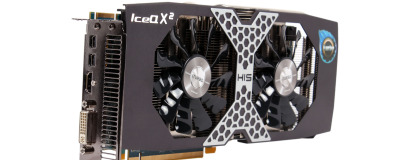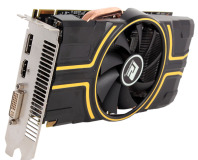HIS Radeon R9 270X IceQ X2 Turbo Boost Review
Written by Matthew Lambert
December 16, 2013 | 09:14
Companies: #his

Power Consumption (Idle and Gaming)
In order to get an idea of a GPU's real world power draw, we run our Crysis 3 2,560 x 1,600 benchmark, which is currently our toughest single screen GPU test. We use a watt meter to measure the maximum total system power draw during the test, and also take an idle reading at the Windows desktop (2,560 x 1,600).Power consumption (idle)
Windows 7 Aero Desktop
- AMD Radeon R7 260X 2GB
- Nvidia GeForce GTX 660 2GB
- Nvidia GeForce GTX 650 1GB
- Nvidia GeForce GTX 650 Ti Boost 2GB
- Nvidia GeForce GTX 650 Ti 1GB
- AMD Radeon HD 7850 2GB
- Nvidia GeForce GTX 770 2GB
- AMD Radeon HD 7770 1GB
- AMD Radeon HD 7750 1GB
- AMD Radeon R9 270X 2GB
- HIS Radeon R9 270X IceQ X2 Turbo Boost 2GB
- AMD Radeon HD 7870 2GB
- Nvidia GeForce GTX 660 Ti 2GB
- Nvidia GeForce GTX 760 2GB
- AMD Radeon HD 7950 3GB with Boost
- AMD Radeon HD 7790 1GB
- AMD Radeon HD 7970 3GB GHz Edition
- AMD Radeon R9 280X 3GB
- Nvidia GeForce GTX 670 2GB
- Nvidia GeForce GTX 680 2GB
-
103
-
103
-
103
-
104
-
104
-
106
-
106
-
106
-
106
-
107
-
107
-
108
-
109
-
110
-
110
-
110
-
110
-
111
-
111
-
112
0
25
50
75
100
125
System Power Consumption in Watts
Power consumption (load)
Crysis 3 (2,560 x 1,600, 0x AA, Very High Settings)
- AMD Radeon HD 7750 1GB
- Nvidia GeForce GTX 650 1GB
- AMD Radeon HD 7770 1GB
- AMD Radeon HD 7790 1GB
- Nvidia GeForce GTX 650 Ti 1GB
- AMD Radeon HD 7850 2GB
- AMD Radeon R7 260X 2GB
- AMD Radeon HD 7870 2GB
- Nvidia GeForce GTX 660 2GB
- Nvidia GeForce GTX 650 Ti Boost 2GB
- AMD Radeon R9 270X 2GB
- Nvidia GeForce GTX 660 Ti 2GB
- Nvidia GeForce GTX 670 2GB
- HIS Radeon R9 270X IceQ X2 Turbo Boost 2GB
- Nvidia GeForce GTX 760 2GB
- Nvidia GeForce GTX 680 2GB
- AMD Radeon HD 7950 3GB with Boost
- Nvidia GeForce GTX 770 2GB
- Nvidia GeForce GTX 780 3GB
- AMD Radeon R9 280X 3GB
- Nvidia GeForce GTX Titan 6GB
- AMD Radeon HD 7970 3GB GHz Edition
-
173
-
179
-
196
-
200
-
205
-
227
-
229
-
243
-
244
-
245
-
260
-
266
-
277
-
280
-
295
-
300
-
314
-
333
-
344
-
350
-
352
-
356
0
100
200
300
400
System Power Consumption in Watts
Thermal Performance (Idle and Gaming)
Thermal output is measured using Unigine's free Heaven 3.0 benchmark, as its DirectX 11 features will stress all parts of a modern GPU. We leave all GPU fan profiles and settings as they come. We use the default Unigine settings with a resolution of 2,560 x 1,600 and leave the benchmark running for ten minutes so that temperatures plateau. We record the peak GPU temperature using GPU-Z, and present the data as the delta T (the difference between the GPU temperature and the ambient temperature in our labs). We also take an idle reading at the Windows desktop (2,560 x 1,600).Heat (idle)
Windows 7 Aero Desktop
- HIS Radeon R9 270X IceQ X2 Turbo Boost 2GB
- AMD Radeon HD 7870 2GB
- Nvidia GeForce GTX 760 2GB
- Nvidia GeForce GTX 650 Ti 1GB
- AMD Radeon R7 260X 2GB
- AMD Radeon R9 270X 2GB
- Nvidia GeForce GTX 660 2GB
- Nvidia GeForce GTX 650 Ti Boost 2GB
- Nvidia GeForce GTX Titan 6GB
- Nvidia GeForce GTX 690 4GB
- AMD Radeon HD 7770 1GB
- Nvidia GeForce GTX 780 3GB
- Nvidia GeForce GTX 770 2GB
- Nvidia GeForce GTX 660 Ti
- Nvidia GeForce GTX 680 2GB
- AMD Radeon HD 7970 3GB GHz Edition
- Nvidia GeForce GTX 670 2GB
- AMD Radeon HD 7990 6GB
- AMD Radeon HD 7750 1GB
- Nvidia GeForce GTX 650 1GB
- AMD Radeon HD 7950 3GB with Boost
-
5
-
6
-
7
-
8
-
8
-
8
-
9
-
9
-
10
-
10
-
10
-
10
-
10
-
11
-
11
-
11
-
11
-
12
-
12
-
14
-
16
0
3
5.5
8
10.5
13
15.5
18
Delta T in °C
Heat (load)
Unigine Heaven Benchmark (2,560 x 1,600, default settings)
- Nvidia GeForce GTX 650 Ti 1GB
- Nvidia GeForce GTX 650 1GB
- HIS Radeon R9 270X IceQ X2 Turbo Boost 2GB
- AMD Radeon HD 7870 2GB
- Nvidia GeForce GTX 660 2GB
- PowerColor Radeon R9 270 OC 2GB
- AMD Radeon HD 7750 1GB
- Nvidia GeForce GTX 660 Ti
- AMD Radeon HD 7770 1GB
- Nvidia GeForce GTX 650 Ti Boost 2GB
- AMD Radeon HD 7950 3GB with Boost
- AMD Radeon R9 270X 2GB
- Nvidia GeForce GTX 680 2GB
- AMD Radeon HD 7990 6GB
- AMD Radeon HD 7970 3GB GHZ Editon
- Nvidia GeForce GTX 670 2GB
- Nvidia GeForce GTX 770 2GB
- AMD Radeon R7 260X 2GB
- Nvidia GeForce GTX 760 2GB
- Nvidia GeForce GTX 780 3GB
- Nvidia GeForce GTX Titan 6GB
- Nvidia GeForce GTX 690 4GB
-
30
-
33
-
33
-
40
-
41
-
42
-
42
-
43
-
44
-
48
-
50
-
50
-
54
-
54
-
54
-
55
-
55
-
56
-
57
-
59
-
59
-
63
0
10
20
30
40
50
60
70
Delta T in °C
*As there is no stock model of the AMD Radeon HD 7850 2GB, and we do not have stock samples of the AMD Radeon HD 7790 1GB, AMD Radeon R9 280X or AMD Radeon R9 270 they cannot be included in the thermal performance graphs









Want to comment? Please log in.